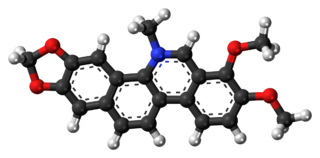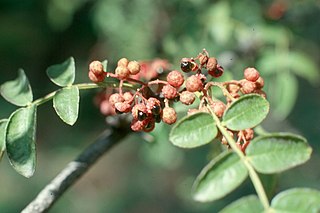
Zanthoxylum is a genus of about 250 species of deciduous and evergreen trees, shrubs and climbers in the family Rutaceae that are native to warm temperate and subtropical areas worldwide. It is the type genus of the tribe Zanthoxyleae in the subfamily Rutoideae. Several of the species have yellow heartwood, to which their generic name alludes.

Zanthoxylum clava-herculis, the Hercules' club, Hercules-club, pepperwood, or southern prickly ash, is a spiny tree or shrub native to the southeastern United States. It grows to 10–17 m tall and has distinctive spined thick, corky lumps 2–3 cm long on the bark. The leaves are glabrous and leathery, pinnately compound, 20–30 cm long with 7-19 leaflets, each leaflet 4–5 cm long. The flowers are dioecious, in panicles up to 20 cm long, each flower small, 6–8 mm diameter, with 3-5 white petals. The fruit is a two-valved capsule 6 mm diameter with a rough surface, and containing several small black seeds. The tree has also been called Z. macrophyllum. The genus name is sometimes spelled Xanthoxylum.
Dihydrobenzophenanthridine oxidase is an enzyme. In the IUBMB Enzyme Nomenclature, dihydrobenzophenanthridine oxidase is EC 1.5.3.12.

Chelerythrine is a benzophenanthridine alkaloid present in the plant Chelidonium majus. It is a potent, selective, and cell-permeable protein kinase C inhibitor in vitro. And an efficacious antagonist of G-protein-coupled CB1 receptors. This molecule also exhibits anticancer qualities and it has served as a base for many potential novel drugs against cancer. Structurally, this molecule has two distinct conformations, one being a positively charged iminium form, and the other being an uncharged form, a pseudo-base.
In enzymology, a reticuline oxidase (EC 1.21.3.3) is an enzyme that catalyzes the chemical reaction
In enzymology, a protopine 6-monooxygenase (EC 1.14.13.55) is an enzyme that catalyzes the chemical reaction

Aristolochia grandiflora, the pelican flower, is a deciduous vine with one of the world's largest flowers that emits an odor that smells like rotting feet, attracting flies.

Zanthoxylum brachyacanthum, known as thorny yellow-wood, satinwood, satin tree or scrub mulga, is a species of flowering plant in the family Rutaceae and is endemic to north-eastern Australia. It is a rainforest shrub or tree with thick, cone-shaped spines on the trunk and prickles on the branches, pinnate leaves, and male and female flowers arranged in panicles.

Zanthoxylum americanum, the common prickly-ash, common pricklyash, common prickly ash or northern prickly-ash, is an aromatic shrub or small tree native to central and eastern portions of the United States and Canada. It is the northernmost New World species in the citrus family, Rutaceae, and is the type species in its genus, which includes sichuan pepper. It can grow to 10 meters (33 ft) tall with a diameter at breast height (DBH) of 15 cm (5.9 in). It produces membranous leaflets and axillary flower clusters. The wood is not commercially valuable, but oil extracts from the bark have been used in traditional and alternative medicine, and have been studied for antifungal and cytotoxic properties. The genus name is sometimes spelled Xanthoxylum.

Zanthoxylum zanthoxyloides, also called Senegal prickly-ash or artar root, is a plant species in the genus Zanthoxylum.
Zanthoxylum dipetalum is a rare species of tree in the family Rutaceae and in the same genus as Szechuan pepper. It is known by the Hawaiian names Kāwa'u and Heaʻe and is endemic to the Hawaiian archipelago, where it grows in forests on 3 or 4 of the islands.

Zanthoxylum rhoifolium is a species of tree in the family Rutaceae known by the common names mamica de cadela, tambataru, and prickly ash. It is native to South America. It is a common tree on the Cerrado.

N-Methylserotonin is a tryptamine alkaloid. Chemically, it is a derivative of serotonin in which a methyl group resides at its alkyl amine. It is also called Nω-methylserotonin (Nω-methyl-5-hydroxytryptamine) to distinguish it from tryptamine-derived compounds in which a methyl group is bonded to the nitrogen atom of the indole group.

Furoquinoline alkaloids are a group of alkaloids with simple structure. Distribution of this group of alkaloids is essentially limited to plant family Rutaceae. The simplest member of this group is dictamnine and most widespread member is skimmianine.
Zanthoxylum gilletii, the East African satinwood, is a tree species in the genus Zanthoxylum found in Africa. The fruits are used to produce the spice uzazi.

Nitidine is a benzophenanthridine alkaloid found in species of the genus Zanthoxylum , notably in Zanthoxylum nitidum. This compound has an anti-malarial activity.

Sichuan pepper, also known as Szechuan pepper, Szechwan pepper, Chinese prickly ash, Chinese pepper, Timut pepper and malapepper, is a spice commonly used in Sichuan cuisine. Despite its name, Sichuan pepper is not closely related to black pepper or chili peppers. It is made from plants of the genus Zanthoxylum in the family Rutaceae, which includes citrus and rue.

Skimmianine is a furoquinoline alkaloid found in Skimmia japonica, a flowering plant in family Rutaceae that is native to Japan and China. It is also a strong acetylcholinesterase (AChE) inhibitor.
Zanthoxylum austrosinense, or South Chinese Sichuan pepper, is a woody plant in the family Rutaceae and is native to southern China.
Zanthoxylum kwangsiense is a woody plant from the Rutaceae family, it is native to northwestern Guangxi, Guizhou (Libo), and Sichuan China.













